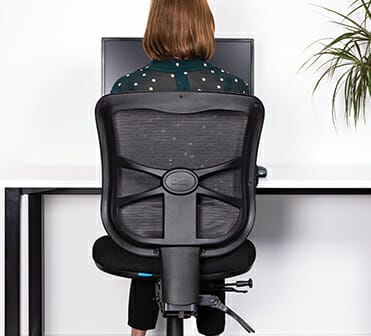In many office jobs, we’re stuck at our desks all day, with very few of us enjoying the luxury of regular trips out and about. Sitting for long periods can have a lasting impact on the body; after all, humans weren’t designed to maintain one position all day.
Extended periods of sitting down without an ergonomic chair, and suboptimal posture can cause damage to your body over time. This can lead to back pain, poor posture, neck aches, and even wrist problems. But your upper body doesn’t need to suffer; here are some tips to avoid a sore body and minimise long-term health risks.
Health issues associated with long periods of sitting
While you might have worked in an office for years without experiencing any health problems, you’re probably one of the lucky ones. Sitting down all day will eventually take a toll on the body, especially as you get older.
Unlike our ape ancestors, the human body is designed for regular movement, according to scientific studies. When we’re sitting down all day, every day, our muscles become weak, strained, and our bodies are more prone to injuries.
Sitting for long periods in the office can lead to health problems, including:
- Weakening of core muscles, legs and glutes
- Poor posture
- Back pain
- Obesity
- Vascular (blood flow) problems
If those issues aren’t concerning enough, sitting at work and a sedentary lifestyle both appear to be independent contributors to cancer, much like eating too much red meat or smoking, according to Oncologists.

Three tips for managing sitting throughout the workday
Even if you lead an active lifestyle outside of work, sitting for prolonged periods can harm your health. Here are three tips to keep yourself in the best possible shape:
Tip #1. Use an ergonomic workstation
Organising an ergonomic workstation is the most important step you can take to safeguard your health in the office. Read our guide on how to set up an ergonomic workstation for optimal health and performance.
Here’s a breakdown of what you’ll need:
- An ergonomic chair that can support your back and promote good posture. Look for adjustable features, such as seat height, backrests and armrests, and quality materials.
- A desk that is at the right height, keeping your arms flat.
- A keyboard and mouse at a comfortable height and distance to prevent strain on your wrists and shoulders.
- A computer monitor at eye level to avoid straining your neck.
Whether you work from home or in the office, getting ergonomics right will help you maintain posture and reduce the risk of musculoskeletal issues.
Other tips to avoid injuries
Most of us are familiar with the horrible feeling of waking up in an aeroplane seat, with a neck ache and muscles well and truly strained. Being in a fixed position for a long time isn’t good for you, so make use of the space in your office and take a stroll when you can.
Tip #2. Go on breaks
To help you stick to a regular break schedule, use a timer or productivity app on your phone. During your breaks, stand up, stretch, and walk around. Use breakout areas with booth seating and relax in a different position for a few minutes.
Even small bursts of activity can be beneficial in the long run. Incorporate more movement into your daily routine and you’ll reap the rewards.

Tip #3. Do chair exercises
Try some chair exercises and perform small stretches to loosen up your muscles and release tension.
The following exercises can help to improve circulation and alleviate tightness. They only take a second, but incorporating them into your daily routine can counteract the harm caused by sitting down all day.
Core exercise
Sit up straight and squeeze your abdominals to activate your core. Hold for a short while, then let go. Repeat throughout the day. Watch video demonstration.


Leg exercises
Lift and hold one leg at a time for a few seconds. Alternate between legs to engage your leg muscles. Watch video demonstration.
Shoulder rolls
Roll your shoulders forward and backwards in a circular motion to release tension in your neck and shoulders. Watch video demonstration.


Neck stretches
Gently tilt your head to one side, bringing your ear towards your shoulder. Hold for a few seconds and repeat on the other side.
For a more detailed range of office stretches, check out some more top tips from our ergonomist friend Andrew Wilson. You won’t regret it.
Now you know about the risks of sitting for long periods, and the best way to protect your health and posture.
Check out our range of ergonomic office chairs that can minimise the risk of injuries and provide optimal comfort.




